Yerba mate [ˈɟɛrβa ˈmate] is drunk mainly in Argentina, Brazil, Paraguay and Uruguay.
It is an equivalent of our tea or coffee, which traditionally accompanies our social gatherings.
The taste of mate, however, is by no means similar to black tea or coffee. It could be compared to the taste of green tea but true mate lovers would of course deny it.
Both mate and green tea are bitter but the bitterness is of different kind. Yerba mate is not only a beverage, it is rather a social event – often drunk when you want to chat with your friends. Because of that employers in South America sometimes forbid drinking mate at work.
In above mentioned countries yerba mate is consumed almost habitually, which is reflected by
numbers: the average Argentine buys nearly 7 kilograms of mate yearly.
And now some basic information.
“By the name yerba or yerba mate one understands a product consisting of dried, slightly toasted, ground leaves of Ilex paraguariensis Saint Hilaire, alternatively with an addition of fragments of dried young sprigs, sprouts or flower stems. (...)”
(Argentine Alimentary Code; No. 18.284, Chapter 15, Article 1193)
Yerba mate, Ilex paraguariensis, is a specie of holly (family Aquifoliaceae). In its natural habitat, during 25 years it may grow up to 15 m, while cultivated — up to 3–6 m. It blossoms from October till December. Its leaves are elongated, evergreen and glossy, up to 5 cm long, with a serrated margin; small, yellowish, 4-petal flowers are gathered in bunches sprouting from the edges of leaves; fruit — violet-red drupe with several seeds. The natural habitat, as well as the area of cultivation, is limited to the South America, more precisely to the zone between the Atlantic Ocean and Paraguay river, and between 18°S and 30°S. Leaves contain caffeine and theobromine — alkaloids that stimulate central nervous system. Some researches [Kamangar et al.] show high concentration in leaves and infusions of polycyclic aromatic hydrocarbons (including benzo-α-piren), which are human carcinogens.
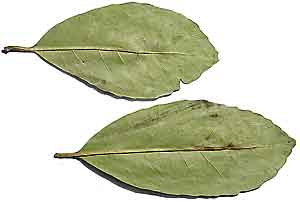
Dictionary
p — Portuguese, g — Guaraní, other words are of Spanish origin
azucarera — sugar bowl
bomba — (p) » bombilla
bombilla — a small pipe through which you drink mate, tipped with a filter, usually made of metal (stainless steel, silver); can be straight or curved; filter is often disassemblable; there is a thickening by the mouthpiece, which absorbs heat
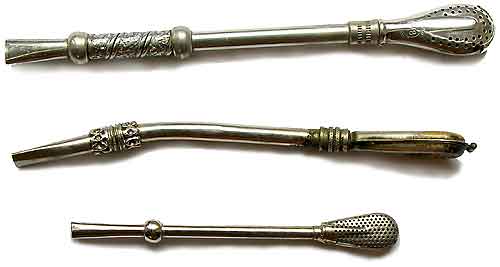
canchado — one of the stages in the production process, when the leaves are coarsely ground
cebador — a person that serves mate, a master of ceremony
chá-mate — (p) » mate cocido
chimarrao — (p) » yerba mate (1)
erva mate — (p) » yerba mate
galleta — mate (2) of round flattened shape
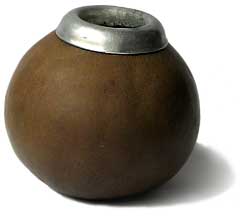
guampa — [Quechua huampa — horn] mate (2) made of cattle horn
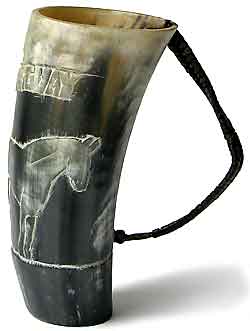
ka'a — (g) » yerba mate (3)
ka'ay — (g) » mate (1)
ka'ygua — (g) » mate (2)
mate — [Quechua mati — gourd] 1. a beverage made by pouring hot (not boiling) water over yerba mate; 2. a vessel for drinking mate, usually made of gourd (Lagenaria vulgaris); also of wood - eg. hard guayacan (palo santo), cattle horn, metal
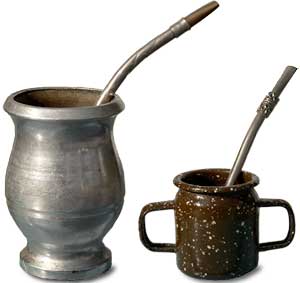
~ amargo, ~ cimarrón, ~ verde — mate without sugar
~ cocido, ~ yerbeado — mate drunk like tea, in a cup, poured with boiling water
~ de leche — mate with milk instead of water
~ dulce — mate with sugar
~ lavado — mate after many refills, without taste
cebar el ~ — to prepare mate, to pour water to mate
curar el ~ — to prepare a gourd for the first use
matero — a person drinking mate
pava — a kettle
poro, porongo — (in North-Eastern Argentina, Southern Brazil) mate (2) of elongated shape, pear-like
tereré — (g) (especially in Paraguay) yerba mate poured with cold water, often drunk with ice, herbs, juice; the name derives from the sound of slurping
yerba mate — 1. dried, ground leaves of yerba mate prepared for making infusions; 2. fresh leaves of yerba mate; 3. yerba mate tree (Ilex paraguariensis)
~ canchada — semi-finished product in the yerba mate production process; dried, coarsly ground leaves of yerba mate
~ compuesta — yerba mate with addition of herbs, eg. mint
~ elaborada, ~ elaborada con palo — yerba mate containing not less then 65% of dried leaves and not more then 35% of dried stems, sprigs, sprouts etc. Sometimes the quality of yerba mate is also described by symbol P.U. followed by numer from 1 to 3, where P.U.2 roughly refers to elaborada
~ elaborada despalada, ~ elaborada despalillada — yerba mate containing not less then 90% of dried leaves and not more then 10% of dried stems, sprigs, sprouts etc.; also marked as P.U.1
~ tostada — yerba mate subjected to the process of toasting
yerbera — a container for storing yerba mate (1)
zapecado — first stage of the processing of the leaves when they are briefly exposed to very high temperature (up to 460°C)
And now some basic information.
“By the name yerba or yerba mate one understands a product consisting of dried, slightly toasted, ground leaves of Ilex paraguariensis Saint Hilaire, alternatively with an addition of fragments of dried young sprigs, sprouts or flower stems. (...)”
(Argentine Alimentary Code; No. 18.284, Chapter 15, Article 1193)
Yerba mate, Ilex paraguariensis, is a specie of holly (family Aquifoliaceae). In its natural habitat, during 25 years it may grow up to 15 m, while cultivated — up to 3–6 m. It blossoms from October till December. Its leaves are elongated, evergreen and glossy, up to 5 cm long, with a serrated margin; small, yellowish, 4-petal flowers are gathered in bunches sprouting from the edges of leaves; fruit — violet-red drupe with several seeds. The natural habitat, as well as the area of cultivation, is limited to the South America, more precisely to the zone between the Atlantic Ocean and Paraguay river, and between 18°S and 30°S. Leaves contain caffeine and theobromine — alkaloids that stimulate central nervous system. Some researches [Kamangar et al.] show high concentration in leaves and infusions of polycyclic aromatic hydrocarbons (including benzo-α-piren), which are human carcinogens.

Composition
of yerba mate infusion. Average values in the infusion prepared of 100 g of dry product. |
|||
| Ingredients | 'tea-bag' infusion |
warm mate |
cold
mate |
| Glucose
(g) Sucrose (g) Proteine (g) Caffeine 1 (g) |
0,54 2,97 3,69 1,27 |
0,59 2,77 2,14 0,85 |
0,15 1,19 1,24 0,44 |
| Vitamins Vitamin C (mg) Thiamine B1 (mg) Niacin (mg) Pyridoxine B6 (mg) |
4,89 1,59 4,38 0,54 |
5,11 1,48 1,27 0,94 |
2,35 0,15 — — |
| Minerals Calcium (mg) Phosphorus (mg) Iron (mg) Magnesium (mg) Potassium (mg) Sodium (mg) |
107,25 60,5 2,54 86,96 99,64 27,54 |
80,94 45,89 2,22 58,58 100,59 14,04 |
43,90 21,27 1,10 33,17 41,63 11,07 |
| 1 Caffeine in yerba mate is sometimes reffered to as mateine. At the same time there are no proofs that this alkaloid differs from caffeine. It is rather a marketing trick. | |||
Dictionary
p — Portuguese, g — Guaraní, other words are of Spanish origin
azucarera — sugar bowl
bomba — (p) » bombilla
bombilla — a small pipe through which you drink mate, tipped with a filter, usually made of metal (stainless steel, silver); can be straight or curved; filter is often disassemblable; there is a thickening by the mouthpiece, which absorbs heat

canchado — one of the stages in the production process, when the leaves are coarsely ground
cebador — a person that serves mate, a master of ceremony
chá-mate — (p) » mate cocido
chimarrao — (p) » yerba mate (1)
erva mate — (p) » yerba mate
galleta — mate (2) of round flattened shape

guampa — [Quechua huampa — horn] mate (2) made of cattle horn

ka'a — (g) » yerba mate (3)
ka'ay — (g) » mate (1)
ka'ygua — (g) » mate (2)
mate — [Quechua mati — gourd] 1. a beverage made by pouring hot (not boiling) water over yerba mate; 2. a vessel for drinking mate, usually made of gourd (Lagenaria vulgaris); also of wood - eg. hard guayacan (palo santo), cattle horn, metal

~ amargo, ~ cimarrón, ~ verde — mate without sugar
~ cocido, ~ yerbeado — mate drunk like tea, in a cup, poured with boiling water
~ de leche — mate with milk instead of water
~ dulce — mate with sugar
~ lavado — mate after many refills, without taste
cebar el ~ — to prepare mate, to pour water to mate
curar el ~ — to prepare a gourd for the first use
matero — a person drinking mate
pava — a kettle
poro, porongo — (in North-Eastern Argentina, Southern Brazil) mate (2) of elongated shape, pear-like
tereré — (g) (especially in Paraguay) yerba mate poured with cold water, often drunk with ice, herbs, juice; the name derives from the sound of slurping
yerba mate — 1. dried, ground leaves of yerba mate prepared for making infusions; 2. fresh leaves of yerba mate; 3. yerba mate tree (Ilex paraguariensis)
~ canchada — semi-finished product in the yerba mate production process; dried, coarsly ground leaves of yerba mate
~ compuesta — yerba mate with addition of herbs, eg. mint
~ elaborada, ~ elaborada con palo — yerba mate containing not less then 65% of dried leaves and not more then 35% of dried stems, sprigs, sprouts etc. Sometimes the quality of yerba mate is also described by symbol P.U. followed by numer from 1 to 3, where P.U.2 roughly refers to elaborada
~ elaborada despalada, ~ elaborada despalillada — yerba mate containing not less then 90% of dried leaves and not more then 10% of dried stems, sprigs, sprouts etc.; also marked as P.U.1
~ tostada — yerba mate subjected to the process of toasting
yerbera — a container for storing yerba mate (1)
zapecado — first stage of the processing of the leaves when they are briefly exposed to very high temperature (up to 460°C)
Number of votes: 16157







